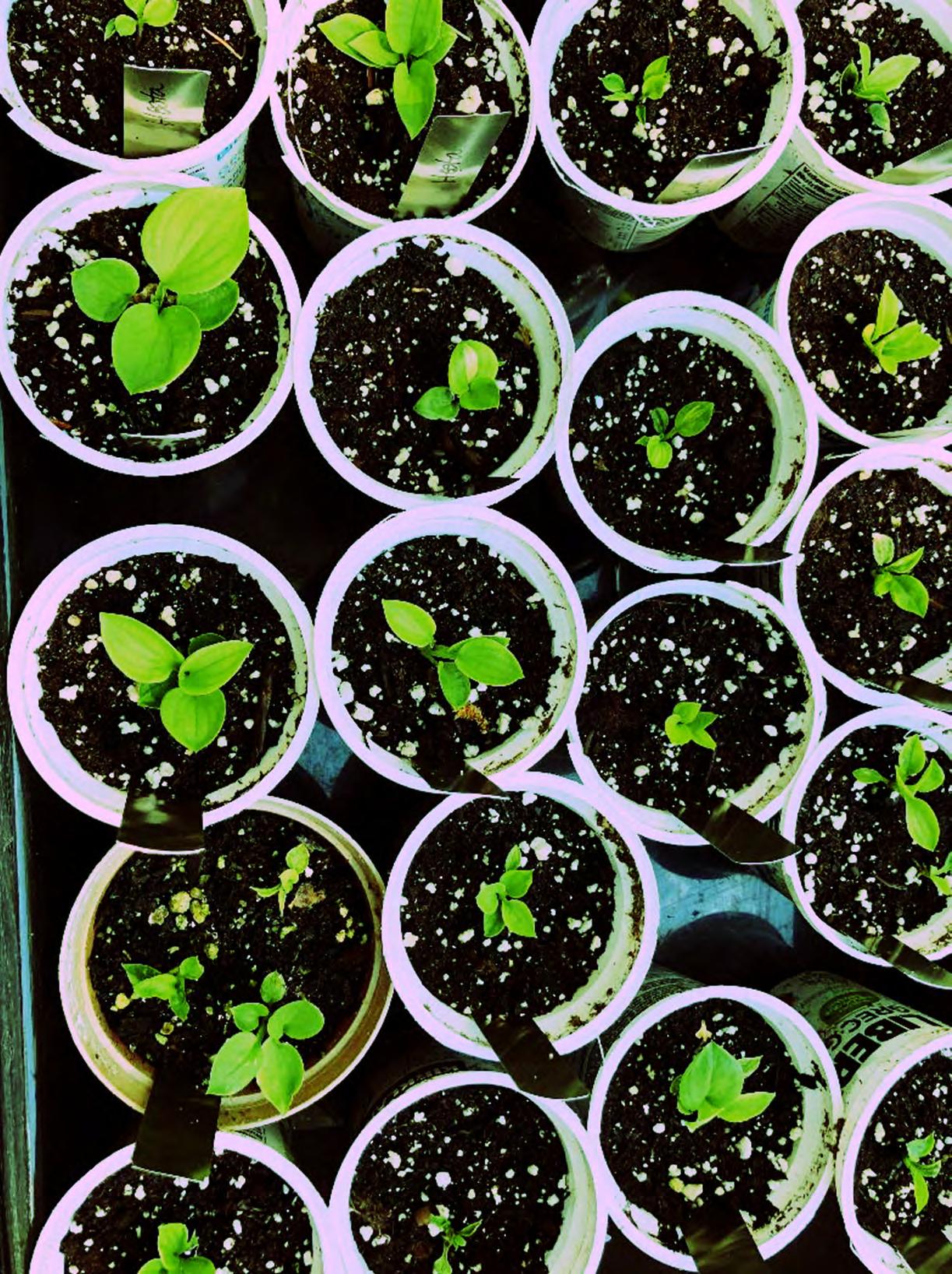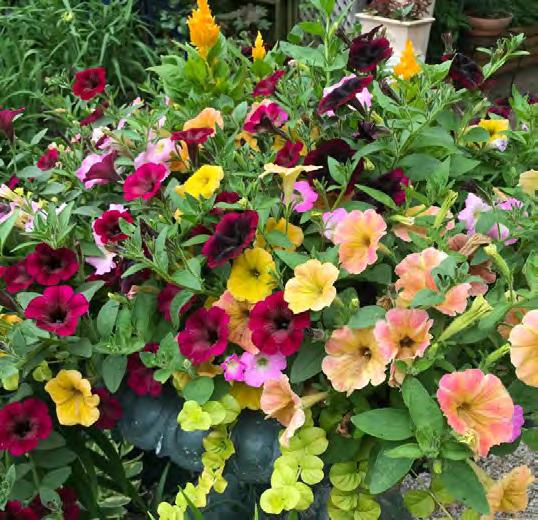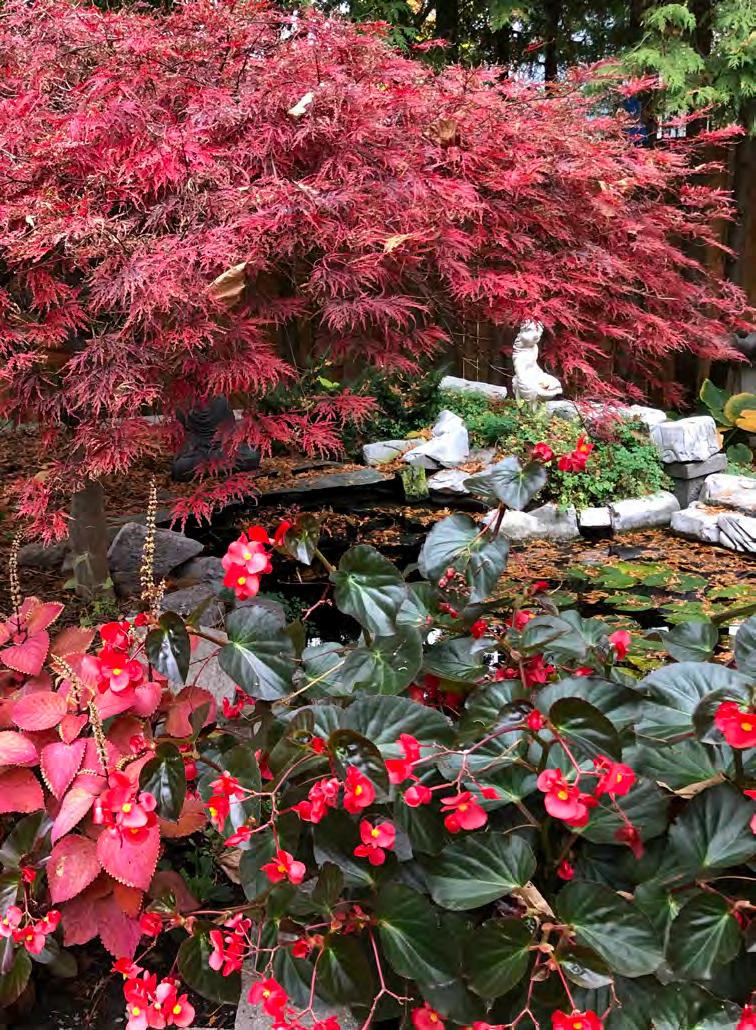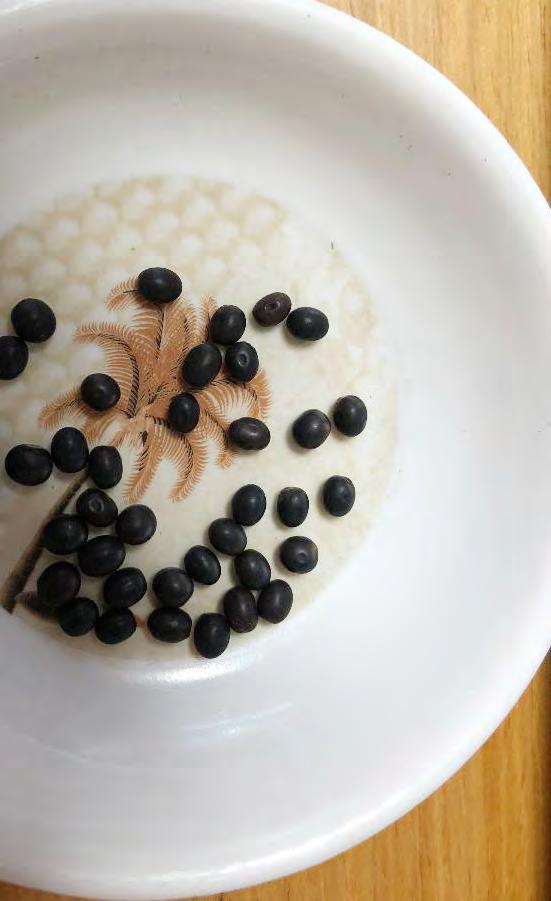
6 minute read
GROW YOUR OWN
You can get a lot of plants from a packet of seeds for not much money, says garden writer Veronica Sliva
WHEN I STARTED gardening the only annuals you could get in stores were marigolds, impatiens and petunias. Perennials were in short supply too. The best way to obtain an interesting variety of plants was to order seed from mail-order catalogues. It still is. I learned early on that you can get a lot of plants from a packet of seeds for not much money.
When we moved to this home, the backyard was a sea of lawn. That turf had to go…all of it. We replaced it with gravel paths, added borders and installed a bird feeding station right away. Other than some trees and shrubs, almost all my plants are started from seed. This article is about my method of growing ornamentals from seed.
SOURCING SEEDS
MAIL ORDER retailers still offer far more choice. One of my favourite seed suppliers is Chiltern Seeds (England). They have a great selection of seed, but it is their irresistible bargains that keep me coming back. Chiltern’s policy is not to stock seed for more than one season. They offer the surplus “for those with a sense of adventure” at an extremely low bargain price. You can select from different packets that contain only annuals, perennials, greenhouse plants, even mixtures of trees and shrubs. The contents are of course a mystery, but that is the fun of it. Check it out for yourself https://www.chilternseeds.co.uk/ search?q=1327
In spring the Toronto Botanical Garden’s shop stocks an interesting assortment of seed, too. You can shop online at https://shop.torontobotanical garden.ca/
Other seed companies on my go-to list are:
Richters Herbs: www.richters.com
Stokes Seeds: www.stokeseeds.com
Vesey’s Seeds: www.veseys.com
Swallowtail Garden Seeds: https://www.swallow tailgardenseeds.com
Baker Creek Heirloom Seed Co.: www.rareseeds.com
Renee’s Garden: www.reneesgarden.com

Cosmos grown from seed.
SEED EXCHANGES
SEED EXCHANGES are great sources for obtaining seed, including varieties that are often not available commercially. If you are a member of the Ontario Rock Garden and Hardy Plant Society, you can participate in their seed exchange program. (http:www.onrockgarden.com/page/seedex). In early December, a list of the available seeds is sent out to all members. Each member can order up to 60 packages of seed for $15. Mailings take place in January, leaving lots of time to get the seed started.

Petunia Showstopper grown from collected seeds.
Hardy Plant Society (England)
THE HARDY Plant Society based in England is another great resource and they ship to Canada (https://www.hardy-plant.org.uk/). You can request up to 25 packets of seed. The seed is free but there is an administration charge of £5.50 for International members.

Single begonia capsule with seeds.
COLLECTING SEED FROM YOUR GARDEN
I COLLECT seed every fall. It can be great fun to see what you end up with. However, it is helpful to understand that some seeds can produce plants that look quite different from the parent. For example, I collected seed from a fancy petunia whose blooms were a painterly wash of yellow, pink, and purple. The resulting seed from a single plant produced a dozen plants with entirely different colours. The combination produced a showstopper of a container. However, be prepared that results can be disappointing and you may end up with a plant that is a mere shadow of its parent.
Be sure your seeds air-dry before storing them. I leave them to air-dry for a few days and then package them into paper envelopes. I keep them in a cool, dark spot in my basement.

Red coleus and begonia grown from seed complement the red Japanese maple.
GERMINATING SEEDS
THIS IS where the fun begins. I use the ‘baggie method’. It saves a lot of space and you can easily see when seeds have germinated. You don’t have to constantly check the soil for moisture. The downside is that you still must transplant them into a soilless mix once they have sprouted.
Supplies
• Snack-size plastic baggies
• Sturdy paper towels (Bounty is good)
• A spray bottle filled with water
• Containers
• Soilless Mix
• Seed

Canna seeds
Method
• Cut the paper towel to fit and insert 1 sheet into each baggie. A single layer means you can easily see when the seed sprouts.
• Spritz the paper towel until it is moistened, not soaked.
• Spread the seeds out on the paper towel.
• Close up the baggie, label and date it.
• Place baggies in a warm place. I use clothes pegs to string them on a wire under a shelf in my laundry room. Alternatively, you can ‘file’ them in a box.
• If the seed requires light, I place the baggies near a bright window. Some seeds benefit from a little heat. I place those ones on a heat mat covered with a towel (so the seeds don’t cook).
• I check every couple of days for germination. How long this takes depends on the type of seed.
• For more detailed information on the baggie method, Robert Pavlis, a Southern Ontario Master Gardener and author, explains the process fully in his comprehensive video https:// www.youtube.com/watch ?v=dirz 0WIMQi0.
Some seeds may require special treatment. For example, some perennial seeds need a cold period followed by a warm period before they will germinate. It is important to check the seed packet for instructions.
The Ontario Rock Garden and Hardy Plant Society has an excellent guide that lists hundreds of plants and their germination requirements. Check it out at https://onrock garden.com/index.php/germinationguide/germination-guide

Canna grown from seed
TRANSPLANTING SEEDLINGS
ONCE YOU see the seeds have sprouted it’s time to transplant them into a container filled with a moistened soilless mix. At this stage, the container does not have to be very deep. I recycle small yogurt containers. Be sure to punch holes in the container for drainage. I use an inexpensive soldering tool. It is quick and efficient, but you must be careful not to burn yourself.
With tweezers, I pluck the seedling from the paper towel and insert it carefully into the container filled with soilless mix. Once the seedlings are transplanted, I give them a spritz with water to settle them in and place a plastic dome or plastic wrap on top. Then they go under fluorescent lights to grow.
WICK WATERING
I LIKE a wicking method to water my seedlings. I place the containers on a capillary mat (felt or some other absorbent material) that takes moisture up into the soil from a container filled with water. The plants are never over or under-watered. I have been able to leave my seedlings unattended with few casualties for a two-week vacation. I highly recommend watering mats from Lee Valley Tools https://www. leevalley.com/en-ca/shop/ garden/indoor- gardening/ watering/44627-wateringmat?item=PM121. TOP
THREE ORNAMENTALS FROM COLLECTED SEED
I START DOZENS of different plants from seed every year. But, I always include these three:
1. Begonia boliviensis
The blooms of this begonia come so close to looking like their parent, I can’t tell the difference. It can be intimidating working with begonia seed because the seed is like dust. Fear not! Here is a great article by the American Begonia Society that will show you the way: https://www.begonias.org/ greenhouse/Care/brads_ articles/seedgrowing.htm
2. Canna indica
Canna seeds are large and easy to collect. They have hard shells and must be soaked to germinate. To speed up the process, I use an electric “dremel tool” to drill a tiny hole in the shell until a pale colour is visible, then I soak the seed in water overnight. Once in a baggy, the seeds germinate in only a few days.
3. Cardinal Climber Vine (Ipomoea x multifida)
This climber is very easy to start from seed and is a hummingbird magnet. It comes true to the parent. Check out https://www.renees garden.com/products/ cardinal-climber-vine









